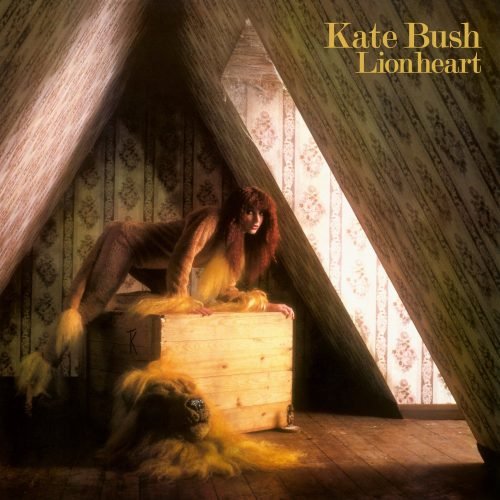In the grand tapestry of Kate Bush’s illustrious career, Lionheart emerges not just as a sophomore effort but as a pivotal chapter that encapsulates the artist’s ceaseless journey into the uncharted territories of pop music. Released in 1978, merely nine months following her groundbreaking debut, The Kick Inside, Lionheart is both a reaffirmation and an expansion of Kate Bush’s artistic ethos. At a time when the music landscape was teeming with punk’s raw energy and disco’s shimmering excess, Bush’s work stood as a testament to the power of nuanced storytelling, intricate melodies, and theatricality.
This album arrives at a crucial juncture, serving as a bridge between the raw, youthful exuberance of her debut and the experimental boldness that would define her later works. Far from being a mere echo of The Kick Inside, Lionheart deepens the exploration of the themes dear to Bush’s heart: myth, fantasy, and human emotion, all the while showcasing an artist unafraid to wield her unique voice amidst the cacophony of the mainstream.
Artistic Intentions

The artistic intentions behind Lionheart are as multifaceted as the album itself. Bush, known for her meticulous attention to detail and her hands-on approach to her music, aimed to create a work that was both deeply personal and universally resonant. Drawing inspiration from literature, cinema, and her own rich inner life, Bush sought to craft songs that functioned as portals to other worlds, inviting listeners to embark on journeys bound only by the limits of their imagination. In interviews from the era, Bush expressed a desire to push beyond the boundaries of conventional songwriting, experimenting with narrative structures, vocal techniques, and instrumentation to evoke a range of emotions and images.
“The song ‘England My Lionheart’, was written from a British pilot’s viewpoint in WW2. He longs for an England that doesn’t exist any more… if it ever did.”
Kate on Oh England My Lionheart
Moreover, Lionheart is an exploration of identity and performance. Through its lush arrangements and evocative lyrics, the album interrogates the personas artists adopt and the masks they wear. In doing so, Bush not only constructs a mesmerizing soundscape but also invites listeners to ponder the facades they themselves maintain in daily life.
Sonic Exploration

The production on Lionheart is a lucid dream rendered in sound, where clarity and richness of texture coalesce to form a sonic landscape that is as expansive as it is detailed. Unlike the lo-fi grit that characterized some of its contemporaries, Lionheart opts for a production style that is crisp, layered, and atmospheric, a choice that not only serves the album’s thematic depth but also amplifies its emotional resonance. Each track is a meticulously crafted soundscape, where the acoustic warmth of piano and strings meets the ethereal qualities of synthesizers and electric guitar, creating a sound that is timeless yet unmistakably rooted in its era.
The clarity of production allows for Bush’s voice to be the beacon that guides the listener through the album’s narrative and emotional twists and turns. Her vocal performances, ranging from the haunting whispers of “In Search of Peter Pan” to the commanding crescendos of “Wow,” are captured with a nuance that ensures every breath and inflection contributes to the album’s storytelling. This production approach not only showcases Bush’s vocal versatility but also serves the album’s themes of fantasy and introspection, making Lionheart an immersive auditory experience.
Musical Arrangements
The musical arrangements on Lionheart are nothing short of a kaleidoscopic journey through Bush’s imaginative prowess. The album weaves a complex tapestry of sounds that blend traditional instrumentation with avant-garde flourishes, creating arrangements that are innovative and memorable. For instance, “Oh England My Lionheart” pairs a plaintive piano with a sweeping string section, evoking a sense of nostalgic longing, while “Kashka From Baghdad” transports listeners with its Eastern-inflected melodies and rhythms, showcasing Bush’s ability to draw from diverse musical traditions to tell compelling stories.
Genre Elements
Lionheart is a veritable odyssey through a myriad of musical genres and subgenres, from the art rock sensibilities that underpin the album’s narrative ambition to the folk motifs that anchor its more introspective moments. However, to say that Lionheart merely touches upon these genres would be an understatement; rather, it blends them in a way that is both novel and deeply personal.
The album defies easy categorization, straddling the boundaries between pop, rock, folk, and even classical, all while infusing these traditional forms with a theatrical flair that is unmistakably Bush. Tracks like “Wow” delve into the world of progressive rock with their complex structures and thematic ambition, while “Symphony in Blue” offers a more introspective take, blending folk and pop elements to create a sound that is as reflective as it is catchy.
Lyrical Analysis

At the heart of Lionheart lies a rich tapestry of themes that range from introspective explorations of identity and longing to fantastical journeys into myth and narrative. Kate Bush crafts a world where the lines between reality and fantasy blur, inviting listeners to lose themselves in stories that are as diverse as they are deeply personal.
One of the central themes of the album is the exploration of English identity and nostalgia, as epitomized by “Oh England My Lionheart.” Here, Bush weaves a narrative filled with imagery of England’s past, creating a sense of longing for a time and place that may only exist in the realm of imagination. This theme of nostalgia is echoed in tracks like “In Search of Peter Pan,” where childhood and the loss of innocence are lamented through references to J.M. Barrie’s famous creation.
Another recurring motif is that of the outsider or misunderstood artist, present in songs like “Wow” and “Hammer Horror.” These tracks delve into the complexities of performance, fame, and the solitary nature of creativity, offering a glimpse into the emotional landscape of those who live their lives on the stage or in the public eye.
Lyrical Depth
The lyrics on Lionheart are a testament to Bush’s prowess as a songwriter and poet. Far from being straightforward and narrative, they are imbued with a complexity and poetic nature that demand and reward careful listening. Bush’s use of imagery and metaphor is particularly striking, creating layers of meaning that are open to interpretation and capable of conveying a wide range of emotions and ideas.
Songs like “Kashka From Baghdad” showcase Bush’s ability to tell stories that are both specific and universal, blending personal and political themes in a narrative about a clandestine gay relationship. The song’s evocative lyrics invite listeners to contemplate issues of love, secrecy, and acceptance, all while painting a vivid picture of its characters and setting.
Emotional Impact
The emotional resonance of Lionheart is one of its most compelling features, with Bush’s lyrics playing a central role in evoking a spectrum of feelings from empathy and joy to sadness and contemplation. The album’s thematic diversity is matched by its emotional range, allowing listeners to find moments of personal connection amidst the fantastical narratives.
For instance, “Don’t Push Your Foot on the Heartbrake” offers a high-energy reflection on risk and recklessness, its driving rhythm and vivid lyrics combining to create a sense of exhilaration and caution. In contrast, “Symphony in Blue” provides a more introspective and melancholic take on the search for meaning and beauty in a confusing world, showcasing Bush’s ability to articulate complex emotional states with poetic clarity.
Cohesion and Flow

Lionheart unfolds like a carefully curated exhibition of musical and lyrical vignettes, each piece contributing to a broader narrative and emotional arc that captivates the listener from start to finish. The album’s track progression is thoughtfully orchestrated, guiding the audience through a spectrum of moods and stories that, while distinct, resonate with a shared essence of introspection, fantasy, and emotional depth.
From the opening chords of “Symphony in Blue” to the closing notes of “Hammer Horror,” there is a palpable sense of journeying through the varied landscapes of Bush’s imagination. While not linear in a traditional storytelling sense, there is an emotional progression that ties the album together. The listener is taken from the reflective and introspective, through the whimsical and fantastical, and into the depths of more complex, darker themes, only to emerge with a sense of catharsis and understanding that comes from having traversed a wide emotional spectrum.
Thematic Consistency
One of Lionheart‘s strengths lies in its thematic consistency. Despite the diversity of its musical and lyrical content, the album maintains a cohesive feel that is unmistakably Kate Bush. The recurring exploration of identity, nostalgia, and the blurring lines between reality and imagination serve as a thread that weaves through the entirety of the album, binding its seemingly disparate parts into a unified whole.
Stylistically, the album navigates through various genres and arrangements with grace and fluidity, ensuring that even its more experimental moments feel in service of the larger narrative and emotional aims. The consistent use of piano and strings across tracks provides a sonic foundation that ties the album together, while Bush’s distinctive vocal performances imbue each song with a personal touch that reinforces the album’s cohesive identity.
However, Lionheart is not without its shifts and turns. Songs like “In Search of Peter Pan” and “Kashka From Baghdad” offer distinct thematic and musical atmospheres, yet these variations do not detract from the album’s overall unity. Instead, they add depth and breadth to its exploration of human emotion and creativity, demonstrating Bush’s skill in crafting an album that is both diverse in its influences and singular in its vision.
Standout Tracks and Moments

Among the lush landscape of Lionheart, several tracks stand out for their artistic innovation, emotional depth, and unique positioning within Kate Bush’s repertoire.
Key Tracks
- “Wow” emerges as a tour de force of theatrical pop, showcasing Bush’s knack for blending intricate narratives with compelling melodies. The song’s commentary on the entertainment industry, coupled with its dramatic vocal delivery and the haunting use of chorus, highlights Bush’s ability to weave complex themes into accessible, yet layered compositions. Its refrain, marked by the emphatic delivery of the titular “wow,” serves as a moment of both climax and introspection, encapsulating the dualities that define much of Bush’s work.
- “In Search of Peter Pan” combines Bush’s love for literature with her musical ingenuity, creating a poignant meditation on lost innocence and the passage of time. The track stands out for its seamless integration of literary references into its lyrics, paired with a melody that is both nostalgic and bittersweet. The use of brass to underscore the song’s emotional peaks adds a layer of depth, making it a striking example of Bush’s talent for storytelling through music.
- “Hammer Horror” is notable for its narrative ambition and sonic experimentation. The track’s exploration of obsession and artistic rivalry is matched by its dynamic arrangement, which includes an eclectic mix of guitar riffs, vocal harmonies, and atmospheric sounds. The song’s ability to create a sense of unease and fascination reflects Bush’s interest in the darker corners of the human psyche, showcasing her ability to push the boundaries of pop music.
Memorable Moments
Lionheart is punctuated by moments of brilliance that capture the essence of the album and highlight Bush’s artistic talents.
- The opening of “Symphony in Blue”, where Bush’s voice, accompanied only by a sparse piano arrangement, sets the tone for the album with its introspective clarity. This moment underscores her ability to convey complex emotions with simplicity and elegance.
- In “Wow,” the dramatic pause before the final chorus serves as a masterful use of silence, amplifying the emotional impact of the song. This pause, brief yet potent, allows the listener to fully absorb the preceding narrative before being swept into the song’s climactic conclusion.
- The instrumental break in “Don’t Push Your Foot on the Heartbrake” features a thrilling guitar solo that not only showcases the musicianship involved in the album but also embodies the song’s themes of recklessness and liberation. This moment, energetic and unbridled, captures the spirit of adventure that pervades much of Bush’s work.
These standout tracks and moments are representative of the artistic merit, innovation, and emotional depth that define Lionheart. Kate Bush’s ability to craft songs that are at once deeply personal and universally resonant, combined with her willingness to explore new musical territories, ensures that the album remains a significant and cherished part of her discography.
Artistic Contribution and Innovation

In the annals of popular music, Kate Bush’s Lionheart occupies a unique position, straddling the realms of art pop and progressive rock while defying the conventions of both. Released at a time when the music industry was dominated by punk’s raw aggression and disco’s pulsating beats, Lionheart stood apart, not merely for its lyrical depth and musical complexity but for its daring to dream differently. Bush’s work on this album can be seen as a precursor to the intricate, genre-blending efforts that would characterize much of alternative pop and rock in the decades to follow.
Lionheart does not so much push boundaries as it does ignore them altogether. In a landscape where female artists were often pigeonholed into specific roles or styles, Bush’s work on the album was a bold declaration of artistic independence. By weaving together elements of folk, classical, and rock, and by delving into themes as diverse as history, literature, and personal introspection, Bush carved out a niche that was distinctly her own. In doing so, she opened doors for other artists to explore their multifaceted identities and interests within their music, challenging the industry’s preconceived notions of what pop music could be.
Innovation
Several aspects of Lionheart stand out for their innovation and freshness, marking it as a significant artistic achievement:
- Thematic Ambition: Bush’s willingness to explore complex, often literary themes set Lionheart apart from much of the music of its time. Her ability to craft songs that function as narratives or character sketches, complete with a beginning, middle, and end, brought a new level of depth to the pop album as a form. This approach has influenced countless artists in the years since, encouraging a more holistic view of albums as cohesive works of art rather than collections of singles.
- Vocal Techniques and Arrangements: Bush’s use of her voice as an instrument in its own right was groundbreaking. On Lionheart, her range—from the ethereal whispers in “In Search of Peter Pan” to the operatic crescendos in “Wow”—showcased a versatility and emotional depth that were rare for the time. Moreover, her innovative use of vocal overdubs to create lush, intricate harmonies added layers of complexity to the album’s sound.
- Musical Arrangements: The album’s arrangements, which seamlessly blend traditional acoustic instruments with more modern, electronic elements, set a precedent for future genre experimentation. The orchestration on tracks like “Oh England My Lionheart” and “Symphony in Blue” combines classical sensibilities with pop accessibility, creating a sound that is both timeless and distinctly of its era.
- Emotional Range: Perhaps one of the most innovative aspects of Lionheart is its emotional breadth. Bush’s ability to evoke a wide range of feelings—from joy to despair, from fear to wonder—within a single album, and sometimes within a single song, was a testament to her songwriting prowess. This emotional complexity has become a hallmark of her work, influencing how artists approach the craft of songwriting.
Closing Thoughts

In the grand landscape of Kate Bush’s discography, Lionheart emerges as a work of profound creativity and bold experimentation. Its strengths lie in its thematic richness, innovative arrangements, and Bush’s unparalleled vocal performances, which together create an immersive listening experience. The album excels in its ability to transport listeners to other worlds, blending fantasy and reality through its lyrical and musical complexity. The emotional depth and range presented across the tracks showcase Bush’s exceptional ability to connect with listeners on a deeply personal level, making Lionheart a testament to her artistic genius.
However, Lionheart is not without its weaknesses. Released just nine months after her debut, the album occasionally bears the marks of its hurried production, with some tracks feeling less polished or cohesive than others. This, coupled with the ambitious nature of Bush’s vision, sometimes leads to moments where the album’s reach exceeds its grasp, leaving certain ideas feeling underexplored or not fully realized. Additionally, while the album’s diversity is one of its strengths, it can also lead to a sense of fragmentation, with the shift between genres and themes potentially jarring for some listeners.
Despite these weaknesses, Lionheart holds a crucial place in Kate Bush’s career as a bridge between the raw talent displayed in her debut and the fully realized artistic vision of her subsequent works. It is a fascinating glimpse into the evolution of an artist unafraid to push boundaries and explore the depths of her creative potential.
Official Rating
Given these considerations, a rating of 7 out of 10 seems appropriate for Lionheart. This score reflects the album’s significant artistic achievements and its impact on the landscape of pop music, while also acknowledging the areas where it falls short of its ambitious goals. Lionheart may not represent the pinnacle of Bush’s career, but it is an essential chapter in her development as an artist, offering valuable insights into her creative process and the themes that would come to define her work.
